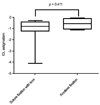Abstract
Purpose
To determine whether the knotless technique can be an alternative for the scleral flap-making technique in posterior chamber intraocular lens transscleral fixation when a scleral flap cannot be made.
Methods
Five patients underwent the knotless technique for posterior chamber intraocular lens transscleral fixation when a scleral flap could not be made. Partial thickness scleral anchoring sutures were repeated three times near the transscleral penetration site in both ends. The end of the anchoring suture was passed under the exposed part of the partial thickness scleral anchoring suture and pulled to adjust the position of the intraocular lens. Then, anchoring sutures were covered with a conjunctival flap. Complications and change of intraocular lens astigmatism were evaluated.
Results
During the 8-month postoperative follow-up period, one case of ciliary body hemorrhage due to intraoperative transscleral penetration and one case of mild intraocular lens tilting owing to the improper tension of the string were observed. Except for one case with a concurrent penetrating keratoplasty, intraocular lens astigmatism showed no significant change during the postoperative follow-up period and no significant difference compared to transscleral fixation with a scleral flap.
Conclusions
Knotless technique for external fixation of posterior chamber intraocular lens transscleral fixation is a safe and easy technique and may be a good alternative for the scleral flap-making technique in posterior chamber intraocular lens transscleral fixation when a scleral flap cannot be made.
Figures and Tables
 | Figure 1A knotless technique for the external fixation of the transscleral suture (A) The anchoring suture with partial thickness scleral penetration of 10-0 polypropylene (Prolene, Ethicon, Somerville, NJ, USA), (B) Partial thickness scleral penetrations were repeated three times, (C) The end of the anchoring suture was buried under the exposed part of the anchoring suture. (D) Representative slit-lamp photography after the knotless techniques for external fixation of the transscleral suture. |
 | Figure 2Comparison of IOL astigmatism between the external fixation with a knot and the knotless external fixation. |
Table 3
Pre and postoperative visual acuities, refractive errors and IOL astigmatisms

BVCA = best-corrected visual acuity; log MAR = logarithm of the minimum angle of resolution; SE = spherical equivalent, D = diopters.
*One case with concurrent penetrating keratoplasty was excluded; †Mean 20.5 days after operation (8-40 days); ‡By power vector analysis; §Underlying glaucoma, anterior uveitis and cystoid macular edema.
References
1. Lewis JS. Ab externo sulcus fixation. Ophthalmic Surg. 1991. 22:692–695.
2. Lewis JS. Sulcus fixation without flaps. Ophthalmology. 1993. 100:1346–1350.
3. Hoffman RS, Fine IH, Packer M, Rozenberg I. Scleral fixation using suture retrieval through a scleral tunnel. J Cataract Refract Surg. 2006. 32:1259–1263.
4. Lin CP, Tseng HY. Suture fixation technique for posterior chamber intraocular lenses. J Cataract Refract Surg. 2004. 30:1401–1404.
5. Scharioth GB, Prasad S, Georgalas I, et al. Intermediate results of sutureless intrascleral posterior chamber intraocular lens fixation. J Cataract Refract Surg. 2010. 36:254–259.
6. Agarwal A, Kumar DA, Jacob S, et al. Fibrin glue-assisted sutureless posterior chamber intraocular lens implantation in eyes with deficient posterior capsules. J Cataract Refract Surg. 2008. 34:1433–1438.
7. Szurman P, Petermeier K, Aisenbrey S, et al. Z-suture: a new knotless technique for transscleral suture fixation of intraocular implants. Br J Ophthalmol. 2010. 94:167–169.
8. Holladay JT, Cravy TV, Koch DD. Calculating the surgically induced refractive change following ocular surgery. J Cataract Refract Surg. 1992. 18:429–443.
9. Holladay JT, Dudeja DR, Koch DD. Evaluating and reporting astigmatism for individual and aggregate data. J Cataract Refract Surg. 1998. 24:57–65.
10. Heilskov T, Joondeph BC, Olsen KR, Blankenship GW. Late endophthalmitis after transscleral fixation of a posterior chamber intraocular lens. Arch Ophthalmol. 1989. 107:1427.
11. Atchison DA. Refractive errors induced by displacement of intraocular lenses within the pseudophakic eye. Optom Vis Sci. 1989. 66:146–152.
12. Atchison DA. Optical design of intraocular lenses. III. On-axis performance in the presence of lens displacement. Optom Vis Sci. 1989. 66:671–681.
13. Rosales P, De Castro A, Jiménez-Alfaro I, Marcos S. Intraocular lens alignment from purkinje and Scheimpflug imaging. Clin Exp Optom. 2010. 93:400–408.
14. Ma DJ, Choi HJ, Kim MK, Wee WR. Clinical comparison of ciliary sulcus and pars plana locations for posterior chamber intraocular lens transscleral fixation. J Cataract Refract Surg. 2011. 37:1439–1446.




 PDF
PDF ePub
ePub Citation
Citation Print
Print




 XML Download
XML Download